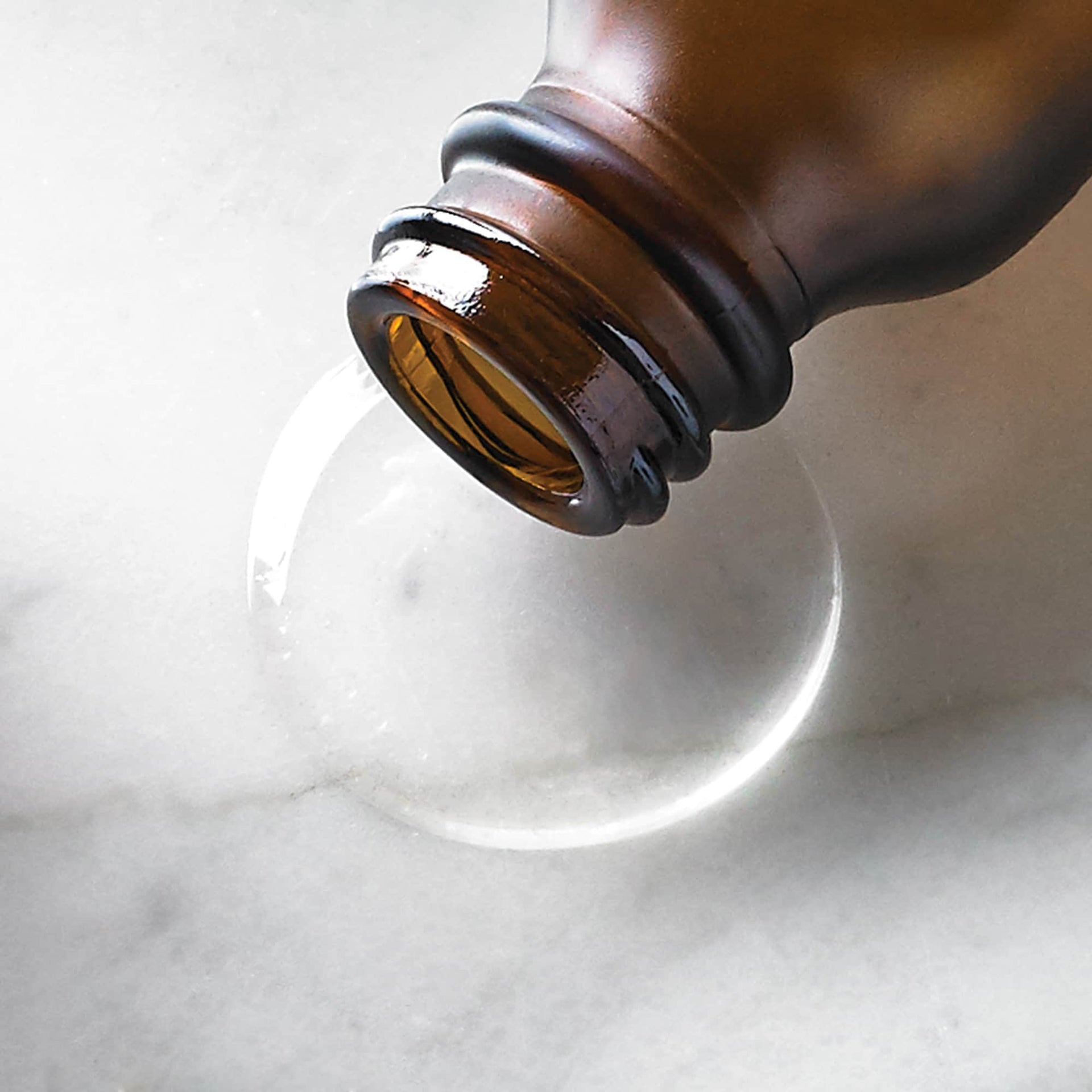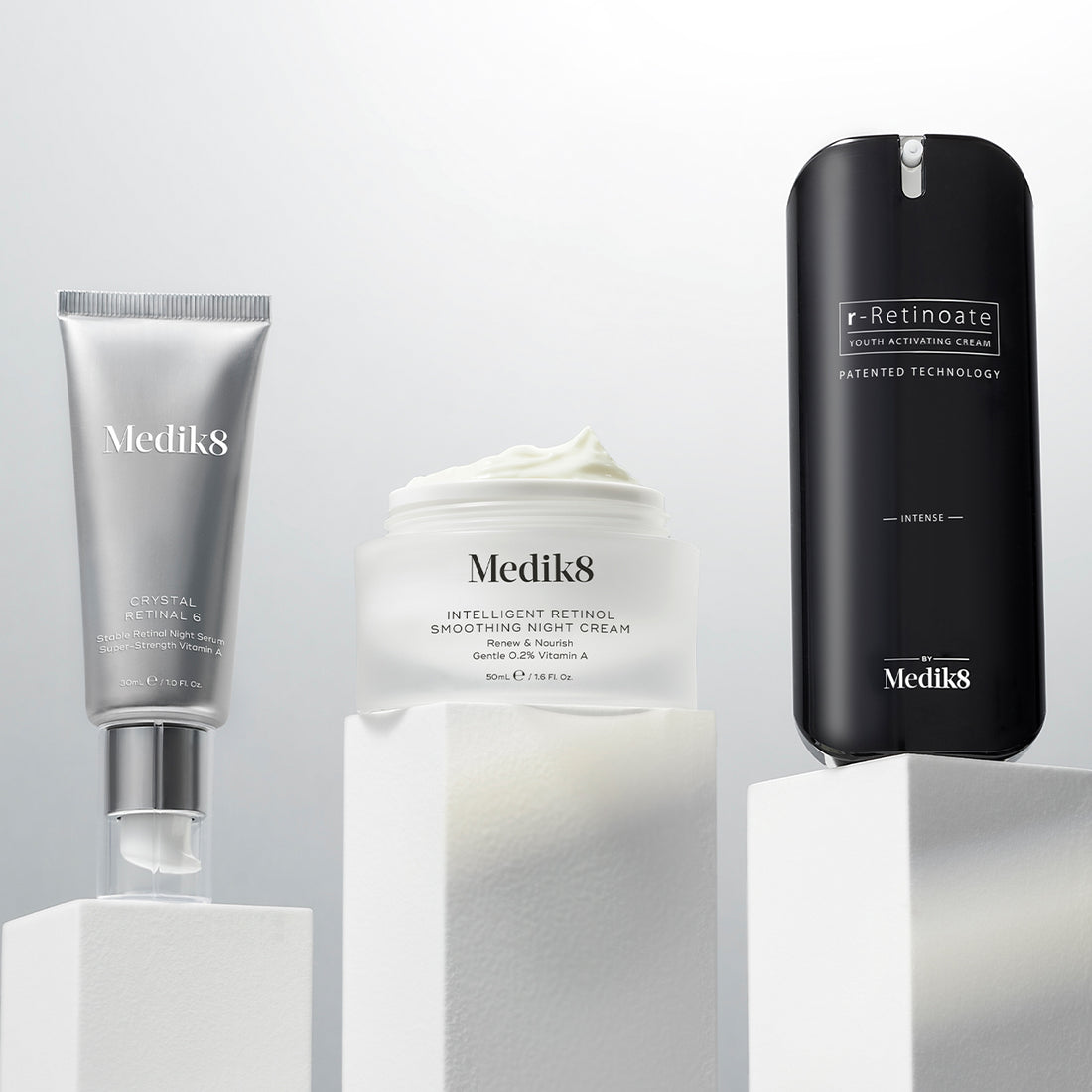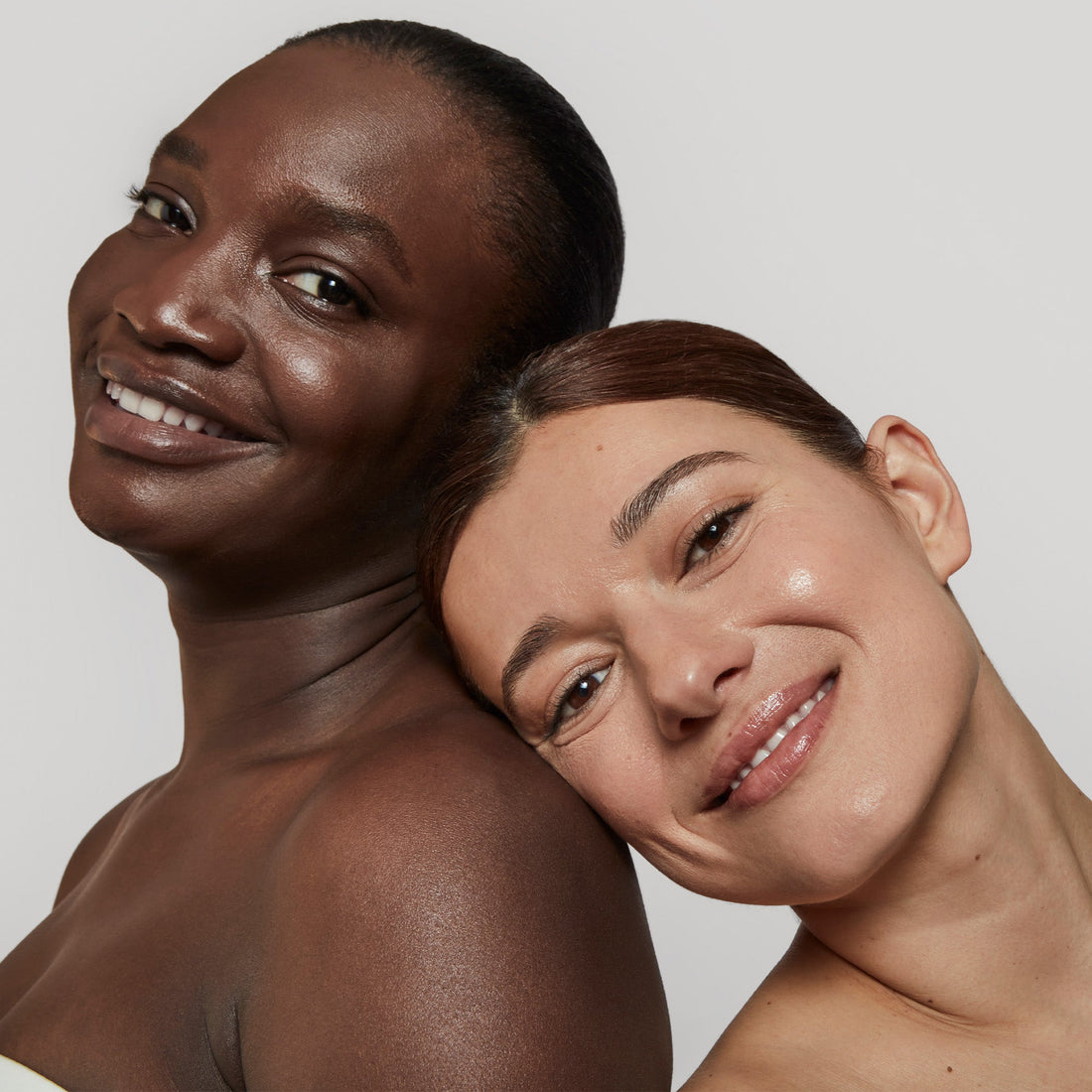A Simple Guide To Using Retinol With Other Skincare Ingredients
Written by: Lucy Partington
Updated on: 28th July 2025

Retinol and retinoids have taken the skincare world by storm. Both are derivatives of vitamin A, lauded for their powerful anti-ageing and skin-renewing properties. However, it can feel a tad overwhelming to navigate their use due to the myriad nuances and caveats associated with these potent compounds. Here, we’ve simplified which skincare ingredients pair well with retinoids and which do not, so you can make informed choices to suit your unique complexion.

Retinol and other retinoids
Retinol, retinal, and other retinoids are often referred to as the ‘gold standard’ for visibly improving skin’s health and appearance. As members of the vitamin A family, they cleverly accelerate cell turnover and boost collagen production, resulting in smoother, firmer, and more youthful-looking skin. Let's dive deeper into what retinol is, how it functions, and key considerations for incorporating it into your skincare routine.
What is it: Vitamin A derivative
Active ingredient: Yes
Forms: Medik8 works with 3 main types of vitamin A molecules: Retinol, retinaldehyde, retinyl retinoate
Benefits:
✓ Reduces wrinkles and fine lines
✓ Improves skin texture and tone
✓ Diminishes hyperpigmentation
✓ Encourages collagen production
✓ Promotes cell turnover
Potential side effects:
• Dryness
• Redness
• Peeling
• Sensitivity
Quick fact: Known as the ‘everyone vitamin A’ retinal works *11x faster than standard retinol to provide remarkable age-defying, skin-smoothing and radiance-boosting results.
*G. Siegenthaler et al., Retinol and retinal metabolism, Biochemical Journal, 1990, 268, pp 371-378
What not to mix with retinoids
Some ingredients can irritate the skin when combined with retinoids. However, they can still benefit your daily routine when used separately — like using one in the morning and retinoids at night — to maximise results without stressing your skin.

Vitamin C
Vitamin C is packed with antioxidant properties, making it a great addition to your morning routine. As an antioxidant, vitamin C can keep the skin barrier at its healthiest state, meaning it’s able to ward off any free radicals your skin encounters. It also supports collagen production, softening the look of fine lines and wrinkles.
What is it: An antioxidant
Active ingredient: Yes
Forms:
• L-ascorbic acid: The most potent and effective form of vitamin C.
• Tetrahexyldecyl ascorbate: A stable, oil-soluble form of vitamin C that penetrates deeper into the skin.
Usage Tips:
Did you know the secret to glowing, youthful skin is as simple as CSA? Medik8’s innovative CSA PhilosophyⓇ is a clinically proven approach to skincare, focusing on three key pillars: Vitamin C and Sunscreen (SPF) in the morning, and vitamin A (also known as retinol/retinal) at night. This philosophy is designed to protect the skin during the day and repair it at night, providing a comprehensive regimen that addresses multiple skin concerns.
Chemical exfoliants: AHAs, BHAs and PHAs
Chemical exfoliants, which are all forms of hydroxy acids, can stimulate exfoliation effectively and gently without being too abrasive, making it easy to incorporate various types of exfoliants into your skincare routine. We would always recommend starting slowly and monitoring your skin’s reaction.
Niacinamide
Niacinamide, also known as Vitamin B3, is a water-soluble ingredient that plays an important role in skin health. It works as an antioxidant, helping to protect and repair the skin from damage while improving its overall appearance.
What is it: Vitamin B3, an antioxidant
Active ingredient: Yes
Usage Tips: Niacinamide is highly versatile and can be added to both your morning and evening routines. It pairs well with most ingredients, including retinoids, to help mitigate potential irritation and enhance overall skin health. Use a niacinamide treatment serum in the morning or apply it before your retinoid in the evening. Ensure you apply a moisturiser and SPF during the day to protect your skin.
Hyaluronic Acid
Hyaluronic acid is a highly effective skincare ingredient known for its powerful hydrating properties. It works as a humectant, attracting and retaining moisture in the skin, which helps to maintain hydration and improve overall skin health.
What is it: Humectant
Active ingredient: Yes
Usage Tips: Hyaluronic acid can be used both morning and night. It is especially beneficial to use it with retinoids, as it helps mitigate dryness and irritation often associated with retinoid use. Apply it before retinoids in the evening and follow with a moisturiser if needed. Alternatively, consider using a retinoid product that includes hyaluronic acid like Crystal Retinal.
Peptides
Peptides are short chains of amino acids that make up certain proteins needed by the skin. These proteins are the foundations of your skin and are responsible for its texture and strength. They work by signalling cells to produce more collagen and elastin, which are essential for maintaining the skin’s firmness and elasticity.
What is it: Amino acids
Active ingredient: Yes
Forms:
• Copper peptides
• Matrixyl
• Argireline
• Palmitoyl pentapeptide
Usage Tips: For optimum results, we recommend applying peptides both in the morning and evening. If using retinoids (vitamin A) in your routine, apply peptides in the morning and retinoids in the evening. This allows you to benefit from the anti-ageing properties of peptides throughout the day while harnessing the powerful skin-renewing effects of retinoids at night. Once your skin has adapted, you can consider applying peptides before your chosen vitamin A product.
Ceramides
Ceramides are fatty molecules known as lipids, that make up more than 50% of the skin. There are two types of ceramides - synthetic, which are lab-created and plant-derived ceramides.
“Think of them as the cement between your skin cells,” says Daniel Isaacs, Chief Product Officer and Founding Partner of Medik8. “They help keep the skin barrier strong and healthy by preventing environmental aggressors from getting in, while simultaneously preventing trans-epidermal water loss.”
What is it: Lipids or fatty acids.
Active ingredient: Yes
Forms:
• Ceramides 1,2,3, 6
• Phytoceramides
• Synthetic Ceramides
Usage Tips: Use ceramides morning and night to support a healthy skin barrier. They pair well with retinoids, helping to reduce dryness and irritation. Follow with a ceramide-rich moisturiser after vitamin A serums to lock in hydration. Try Crystal Retinal Ceramide Eye, which combines ceramides with retinoids for enhanced benefits around the delicate eye area.
SPF
SPF, or Sun Protection Factor, shields the skin from harmful UV rays. It acts as a barrier against UVB radiation, which can cause sunburn and contribute to premature skin ageing. Applying sunscreen regularly helps safeguard the skin's health and maintain its youthful appearance by preventing UV-induced damage.
What is it: Sun Protection Factor measures how well a sunscreen can protect the skin from UV rays.
Active ingredient: Yes
Forms:
• Chemical Sunscreen
• Mineral Sunscreen
• Broad-Spectrum Sunscreen
• Tinted Sunscreen
Usage Tips: Sunscreen is non-negotiable and should always be the last step of your morning skincare routine, applied before makeup. When using retinoids, which should be applied at night, it is crucial to use sunscreen daily to protect your skin from UV damage, not just when using Vitamin A. If irritation occurs, reduce the frequency of retinoid use and consult a dermatologist.
Bakuchiol
Bakuchiol (pronounced bah-ku-chee-ol), derived from the seeds of the Psoralea corylifolia plant, stands out as an antioxidant hero in skincare. Praised for its potent age-defying properties, Bakuchiol enhances skin texture and firmness while providing robust protection against environmental stressors. It's gentle yet effective nature makes it suitable for daily use.
What is it: Antioxidant
Active ingredient: Yes
Usage Tips:
Bakuchiol is a natural alternative to retinoids and can be used in the morning while reserving retinol for the evening. Though not essential, combining them can enhance results. Bakuchiol may cause mild dryness, so follow with a moisturiser. Always use sunscreen daily when using active ingredients.
Benzoyl Peroxide
Benzoyl Peroxide is a cornerstone of acne treatment, renowned for its potent antibacterial properties. Widely used in skincare routines, it effectively targets acne-causing bacteria while aiding in the reduction of inflammation and clearing clogged pores.
What is it: Antibacterial agent
Active ingredient: Yes
Usage Tips:
Combining with retinoids should be avoided as they deactivate each other. While both are effective in treating acne, using them together can lead to increased dryness and irritation. Consider using benzoyl peroxide a few times a week and retinoids on alternate nights. Always apply sunscreen during the day, as benzoyl peroxide can increase sensitivity to sunlight, which can exacerbate skin damage.
Tranexamic Acid
A popular ingredient for tackling hyperpigmentation, tranexamic acid inhibits melanin production to reduce dark spots and even skin tone. It also calms redness and inflammation, making it ideal for sensitive, discolouration-prone skin.
What is it: Water-soluble synthetic ingredient
Active ingredient: Yes
Usage tips: Apply tranexamic acid after cleansing and toning, ideally in the evening. Layer it before retinoids, followed by a moisturiser. Medik8's Press & Clear combines BHAs and tranexamic acid for a gentle yet effective formula that pairs well with vitamin A. Always use sunscreen during the day to protect against UV damage and prevent pigmentation.
Azelaic Acid
Azelaic acid is a multifaceted skincare ingredient hailed for its antibacterial and anti-inflammatory properties. Unlike AHAs (Alpha Hydroxy Acids), BHAs (Beta Hydroxy Acids), or PHAs (Polyhydroxy Acids), Azelaic Acid doesn't primarily function as an exfoliant.
What is it: Antibacterial
Active ingredient: Yes
Usage tips: It's recommended to use azelaic acid in the evening after cleansing and toning. Let it absorb fully before applying retinoids, then follow with a moisturiser. This helps reduce irritation and enhances effectiveness. Use sunscreen during the day to protect against sun sensitivity.
To takeaway
Retinoids can work well with most other skincare ingredients when used correctly, especially with Medik8’s advanced formulations that help reduce irritation. Since every skin is different, it's important to tailor your routine to your specific needs. Gradually introducing retinoids and other actives ensures maximum benefits while minimising side effects.
FAQ's
Retinol should not be mixed directly with strong exfoliating acids like AHAs and BHAs, as this can lead to excessive dryness and irritation. Additionally, avoid using retinol with benzoyl peroxide as they can deactivate each other and reduce effectiveness.
Retinol is best paired with hydrating and soothing ingredients such as hyaluronic acid, niacinamide, peptides and ceramides.
It is generally not recommended to use benzoyl peroxide and retinol together. They can counteract each other and increase the risk of irritation. It’s best to use them at different times of the day or on alternate nights.
At night, you can use retinol with hydrating ingredients like hyaluronic acid and niacinamide. A gentle moisturiser can also be beneficial to prevent dryness.
No, you do not need to wash off retinol in the morning. Retinol is absorbed into the skin while you sleep, making it unnecessary to remove it specifically in the morning. However, it is essential to continue your morning skincare routine, which typically includes cleansing your face and applying sunscreen to protect your skin.







